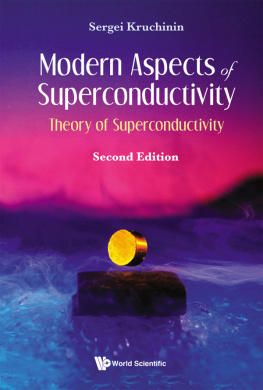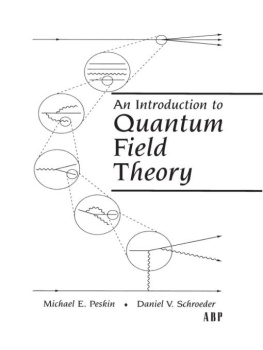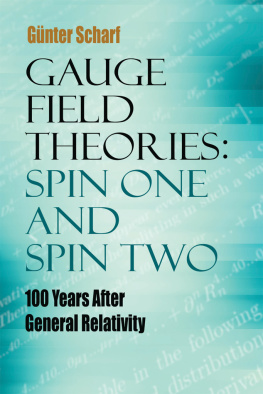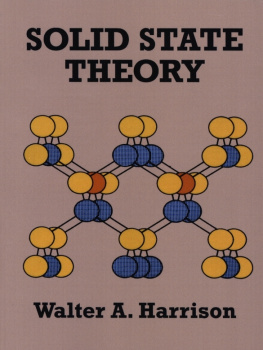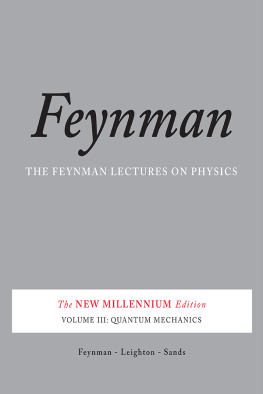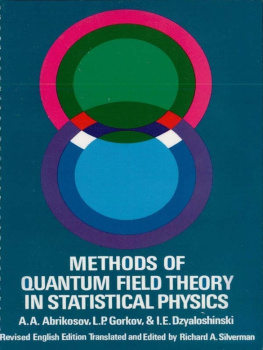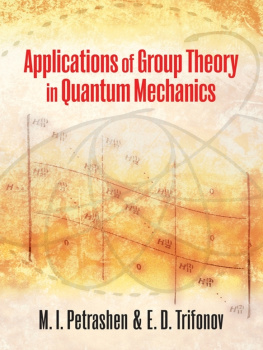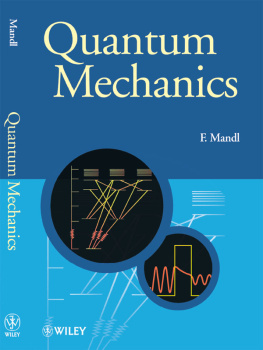THE
QUANTUM
MECHANICS
OF
MANY-BODY
SYSTEMS
Second Edition
David J. Thouless
Department of Physics
University of Washington
DOVER PUBLICATIONS, INC.
Mineola, New York
Copyright
Copyright 1972, 1990 by D. J. Thouless
All rights reserved.
Bibliographical Note
This Dover edition, first published in 2014, is an unabridged republication of the second edition of the work, originally published in the Pure and Applied Physics series by Academic Press, Inc., New York, in 1972.
Library of Congress Cataloging-in-Publication Data
Thouless, D. J.
The quantum mechanics of many-body systems / D.J. Thouless. Second edition.
pages cm.
Unabridged republication of the second edition of the work, originally published in the Pure and applied physics series by Academic Press, Inc., New York, in 1972Title page verso.
Includes bibliographical references and index.
eISBN-13: 978-0-486-78285-0
1. Many-body problem. 2. Quantum theory. I. Title.
QC174.17.P7T47 2014
530.144dc23
2013023770
Manufactured in the United States by Courier Corporation
49357101 2014
www.doverpublications.com
Contents
Preface to the Second Edition
This is the second edition of a book intended as an introduction to that field of theoretical physics known as many-body theory. It is concerned with problems common to nuclear physics, atomic physics, the electron theory of metals, and to the theories of liquid helium three and four, and it describes the methods that have been developed to solve such problems. The aim has been to produce a unified account of the field rather than to describe all the parallel methods that have been developed. The main themes in the line of approach chosen are the self-consistent field and its generalizations, perturbation theory and the use of Feynman diagrams, and the use of Green functions to describe excitations of a many-body system. The main emphasis is on the theories of atomic nuclei, the electron gas, superconductivity, and liquid helium three; there is no discussion of molecular theory or solid helium, and only a brief mention of the theory of interacting phonons in a solid. The reader is expected to be familiar with the principles of non-relatistic quantum mechanics and of statistical mechanics, but a detailed knowledge of nuclear and solid state physics is not assumed.
In this edition I have expanded some important sections which were unreasonably brief in the first edition; I am particularly grateful to those people who have complained to me about such indigestible portions. I have made alterations and additions throughout in the light of developments of the past ten years. A new chapter on impurities and random systems has been added. The increase in size of the book is modest in comparison with the increase in the original literature, and the book can serve only as an introduction to the subject, not as a detailed guide to recent work.
I am grateful to Mr. B. J. Last and Mr. M. Arthur for reading through the manuscript and for suggesting various corrections and alterations.
Preface to the First Edition
This book is intended as an introduction to that field of theoretical physics known as many-body theory. It is concerned with problems that are common to nuclear physics, atomic physics, the electron theory of metals, and to the theories of liquid helium three and four, and it describes the methods which have recently been developed to solve such problems. The aim has been to produce a unified account of the field, rather than to describe all the parallel methods that have been developed; as a result, a number of important papers are not mentioned. The main emphasis is on the theories of atomic nuclei, the electron gas, and liquid helium, and there is no discussion of molecular theory or of solid helium. The reader is expected to be familiar with the principles of nonrelativistic quantum mechanics and of statistical mechanics, but a knowledge of field theory and a detailed knowledge of nuclear and solid state physics are not assumed.
The book developed from a course of lectures given to members of the Mathematical Physics Department at the University of Birmingham, and I am grateful to my colleagues for their advice, encouragement, and criticism. I particularly wish to thank Professor G. E. Brown, Mr. L. Castillejo, Dr. G. V. Chester, Dr. V. J. Emery, Dr. J. A. Evans, Prof. R. E. Peierls, Mr. D. R. Tilley, and Dr. J. G. Valatin for their help, and Dr. R. F. Peierls and Mr. E. Canel who helped to read the proofs. I wish to acknowledge the hosptality of the University Institute for Theoretical Physics at Copenhagen, where a large part of the book was prepared, and to acknowledge my debt to Professor H. A. Bethe, who first stimulated my interest in these problems.
I. Introduction
The many-body systems which we consider in this book are met in several different physical contexts, and so the ideas presented here can be applied to problems which arise in various branches of physics. In nuclear physics, atomic physics, solid-state physics, and low-temperature physics, the types of problem which we discuss arise frequently. It is not so obvious that they also occur in elementary particle physics, but the fact that ideas developed for the study of elementary particles have been applied to many-body problems is an indication that they do indeed occur.
We discuss only those systems for which the symmetry or antisymmetry of the wave functions with respect to interchange of the particles has a dominating influence on the properties of the system. There are, of course, other many-body systems whose properties can only be explained in terms of quantum mechanics; a gas of diatomic molecules is such a system. For such a system, quantum theory is needed only to explain the properties of the individual molecules, and the many-body problem can then be solved without further reference to quantum mechanics. The properties of the systems with which we are concerned here can only be understood in terms of the quantum theory of many-body systems. It is not possible to regard the understanding of the quantum effects and of the many-body properties as two distinct problems. With such systems, it is of the utmost importance whether the constituent particles are bosons, so that the wave function is symmetric, or fermions, so that the wave function is antisymmetric.
The best examples of this sort of system are the two isotopic forms of liquid helium. Both appear to be liquids right down to zero temperature, and this is a fact which cannot be explained by classical mechanics. There is a striking difference between the properties of the two isotopes, much greater than would be expected from the difference in mass between them. Liquid He4 is superfluid below 2.2K, flowing in narrow tubes with no apparent viscosity, while liquid He3 behaves like a normal fluid down to less than 0.003K. This difference is almost certainly due to the fact that the atoms of He4 are bosons, while the atoms of He3 are fermions.
Apart from liquid He3, there are several other examples of many-fermion systems whose properties are strongly affected by the antisymmetry of the wave functions. The electrons in an atom are fermions, but we only give a brief discussion of the theory of atomic structure. The properties of atoms and molecules are not very similar to the properties of other many-fermion systems, since the nuclei, so much heavier than the electrons, affect their structure so profoundly. Atomic nuclei are also composed of fermionsprotons and neutronsand some of the ideas used in nuclear theory are borrowed from atomic theory. It is also possible to regard certain nuclei as composed of alpha-particles, which are bosons, but this is awkward for a number of reasons, and the alpha-particle model has only a limited range of usefulness. The valence electrons in a metal are also fermions, and it might be possible to produce plasmas whose properties are influenced strongly by the Pauli exclusion principle. The so-called electron gas serves as a model for either of these systems. A neutron star, a sphere of neutrons bound together by gravitational forces, is another many-fermion system; pulsars are widely believed to be neutron stars.


